- Author Matthew Elmers [email protected].
- Public 2023-12-16 21:49.
- Last modified 2025-01-24 09:17.
In 2015, the US Armed Forces (AF) announced the long-awaited competition for small arms manufacturers to select a new XM17 army pistol, the MHS (Modular Handgun System) program.
How necessary was a new US Army pistol, after all, the Beretta M-92FS (designated M.9 in the US Armed Forces) is not such an outdated weapon? The main reason for this program is the same as when replacing the Colt M1911 A1 with the Beretta M.9. Over the 15-20 years that the Beretta M.9 pistols have served, many of their elements could have worn out quite seriously, of course, provided that they are not in stock in anticipation of a world war, but are actively used, at least for training purposes.
Of course, some elements, such as the barrel, springs, pins and others, can be replaced, but the laboriousness of diagnostics and repairs, with the replacement of worn out components, can be quite high and financially burdensome. Another option - the purchase of additional lots of M.9 pistols is also ineffective, since experience accumulates during operation, the requirements for an army pistol change, and manufacturers offer new design solutions.
Requirements for the new army pistol began to be developed in 2008 and include a modular design, with the provision of the possibility of replacing pistol elements for shooters with different hand sizes. The controls should be two-sided, with the possibility of convenient use by both right-handers and left-handers. The pistol must be equipped with rails for attaching rifle accessories and various types of scopes. The coating of the pistol should not be slippery or glare.
Pistols must be accurate enough to hit a 4-inch target (10 cm) from 50 meters 90 percent of the time over the life of the weapon. Each proposal was to include two pistols - one full-size, one compact, or one pistol to meet the requirements of both full-size and compact models.
According to the requirements of reliability and durability, the proposed pistols must provide at least 2000 shots without delay, at least 10,000 shots before malfunctions, and guarantee a barrel resource of up to 35,000 shots.
The user's manual for a new military pistol should detail all the steps required to operate the pistol and modify its ergonomic component. The design of the pistol should exclude the possibility of its complete disassembly by untrained users (read soldiers). Complete disassembly must be carried out by the unit's gunsmith using special tools.
An interesting point, despite the fact that the US Army uses the standard NATO cartridge 9x19, there was no strict caliber / cartridge requirement for the pistol under the MHS program. Due to complaints from the military about the insufficient lethality of the 9x19 cartridge when using pistols of this caliber in combat zones such as Iraq and Afghanistan, manufacturers could offer weapons of other calibers, such as.40 S&W.45 ACP,.357 SIG, FN 5, 7 × 28 mm.
In addition, the possibility of using expansive and fragmented bullets in the new army pistol was considered. The Hague Convention of 1899, prohibiting their use in hostilities, was not signed by the United States, although until now it has been observed. It is believed that the use of expansive and fragmented bullets in the 9x19 cartridge will increase its stopping and damaging effect without switching to another caliber.
As with previous attempts to replace the army pistol in 1978-1988, obstacles arose. The Armed Services Committee of the US House of Representatives demanded that the MHS program be canceled and the Beretta M.9 pistol be upgraded instead. Beretta company, wishing to be guaranteed to remain the main supplier of army pistols to the army
The USA, even before the official start of the MHS program was announced, presented in December 2014 a modernized Beretta M9A3 pistol, which partially meets the requirements of the US Armed Forces for a new pistol.
The Beretta M9A3 pistol is a further development of the Beretta M.9 / M-92FS model. It is equipped with guides under the barrel, a replaceable front sight, a grip with a smaller reach. In the muzzle of the barrel there is a thread with a removable protective sleeve, designed to install a quick-release muffler.
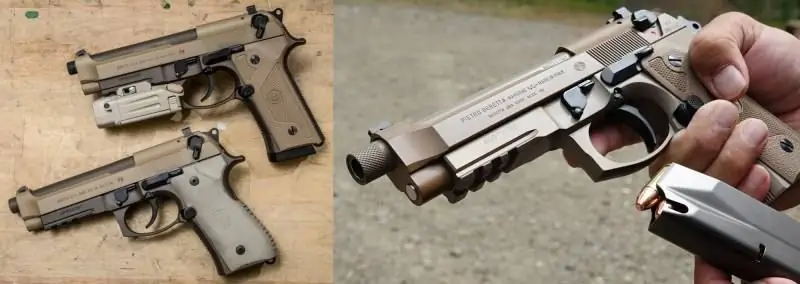
However, the offer from Beretta was rejected, the House of Representatives of the US Congress approved the costs of the new pistol, and in August 2015, the US military officially announced the start of the MHS program, indicating the cost of the program in the amount of $ 580 million.
Testing of the pistols was scheduled to take place before the end of 2017, and starting in 2018, the winner was to supply the US military with 280,000 standard M17 pistols for the army replacing the Beretta M.9, 212,000 M17 pistols for other services and 7,000 compact versions of the M18.
In total, pistols provided by eight weapon companies were selected for testing.
Beretta submitted a new APX pistol to the competition. The Czech company Ceska zbrojovka participated with a compact pistol CZ P-07 and a full-size CZ P-09 in caliber 9x19 and.40 S&W. The American branch of FN America LLC of the Belgian company Fabrique Nationale presented the FN 509 pistol specially designed for the requirements of the MHS program.
Sphinx presented the SDP pistol for the competition. Austrian Glock Participated with Glock 19 MHS pistols chambered for 9x19 and Glock 23 MHS chambered for.40 S & W. SIG Sauer presented the P320 MHS in full-size and compact versions. American companies participated - Smith & Wesson with an M&P M2.0 pistol, STI-Detonics and an STX pistol.
According to some reports, pistols from Heckler & Koch, Springfield Armory, Taurus and Walther were also considered as applicants, but they did not officially take part in the competition.
Since the Beretta M9A3 pistol did not have a compact version, and in a number of parameters it did not meet the requirements of the MHS competition, Beretta participated with a new APX pistol. Presumably, this pistol was developed specifically for the requirements of the MHS program, including a modular design. To meet the requirements of the MHS program, the Beretta APX is equipped with a non-automatic safety lock, while for civilian use there is a version only with an automatic safety lock, like on Glock pistols.
The Beretta APX pistol uses a short-travel automatism and is locked by a skewed breech end. The bolt is made of stainless steel, the frame of the pistol is made of impact-resistant polymer, the USM is striker, with a preliminary cocking of the trigger and a pre-cocking when the trigger is pulled.
Presumably, one of the factors that played against the Beretta APX pistol was the absence at the beginning of the MHS program of serial production of these pistols and their sale to any law enforcement agencies.
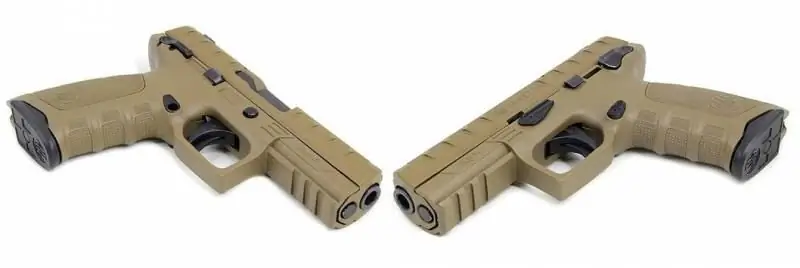
The CZ P-07 and P-09 pistols, presented for the competition by the Ceska zbrojovka company, are based on the design of the CZ-75 pistol, which is well known to athletes involved in practical shooting. The pistols are based on a polymer chassis with a steel bolt and have a new (in relation to the CZ-75) Omega double-action trigger trigger with a smoother trigger. Automation is based on the use of recoil with a short stroke of the barrel, locking is carried out using a descending breech of the barrel. The controls and the shape of the gun are optimized for use with gloves.
According to user reviews, the pistol is convenient and accurate. Apparently, the US Army was not satisfied with the modularity of the CZ P-07 and P-09 pistols, which consists only in the possibility of replacing the rear of the grip, which is probably why Ceska zbrojovka refused to officially participate in the competition.
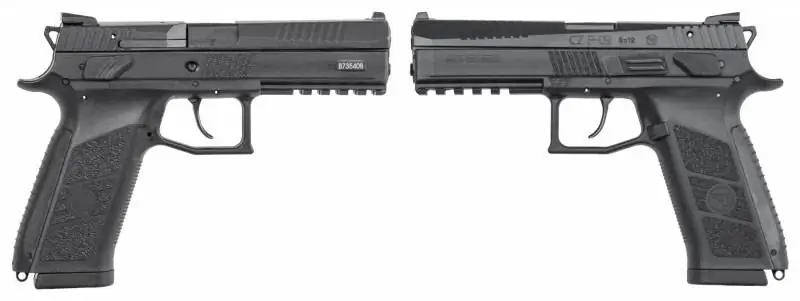
FN America LLC entered the MHS competition with one FN 509 pistol, which was offered as a full size and compact version. The frame of the pistol is polymer. The pistol automatics works according to the scheme of using the recoil of the moving barrel with its short stroke, locking with the help of the descending barrel, clutching the upper protrusion of its breech with an enlarged window for ejection of spent cartridges. USM drummer, with a pre-cocked drummer.
As with the CZ P-07 and P-09 pistols, the FN 509 pistol is not modular in design.

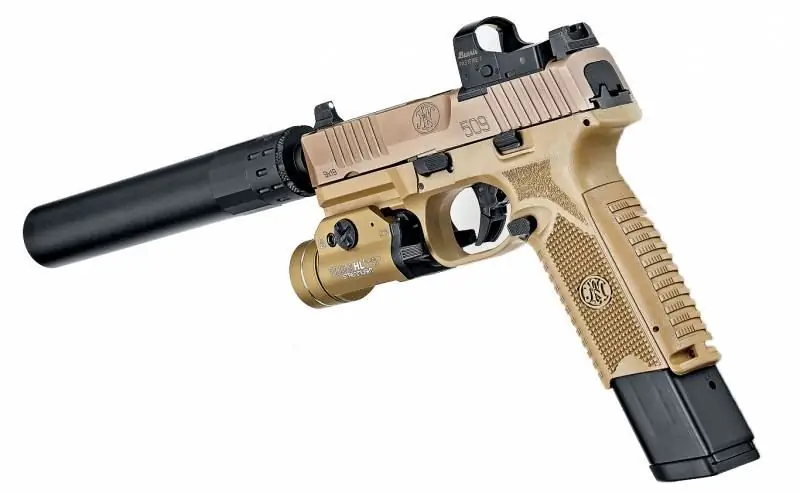
For the Swiss Sphinx SDP pistol, the data differ, according to some sources, both the full-size version and the Compact version participated, according to other sources only the Compact version, which, however, is not so important. Sphinx pistols trace their ancestry to the CZ 75 pistol, and the SDP model was no exception, respectively, its design is similar to that of its progenitor, with minor changes. This pistol lacks modularity, and the price is probably higher than the competition (payment for high quality workmanship), respectively, the probability of winning this sample from the very beginning was minimal.
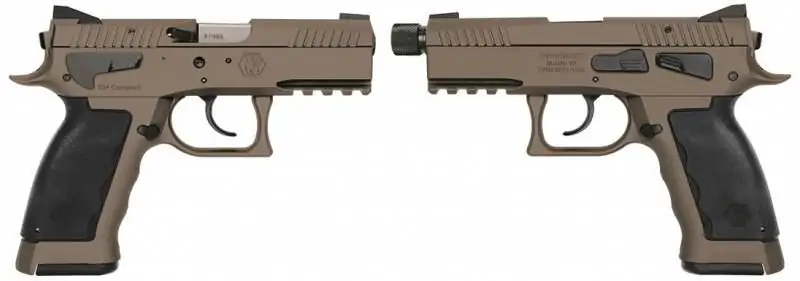
The Austrian company Glock, for the sake of the MHS competition, made unthinkable sacrifices by releasing versions of their pistols with a non-automatic safety catch (previously this was done only according to the requirements of the "native" Austrian army). Due to the safety catch, the thickness of the pistols increased by 2 mm.
Initially, it was assumed that Glock 17 / Glock 19 pistols in caliber 9x19 and Glock 22 / Glock 23 in caliber.40S & W would participate in the competition. However, the Austrians surprised everyone by presenting, so to speak, "hybrid" versions of these models - Glock 19 MHS and Glock 23 MHS. So Glock 19 MHS in height corresponds to Glock 17, and in length of the barrel and body Glock 19. Accordingly, for Glock 23 MHS these are the dimensions of Glock 22 and Glock 23. The front faces of the bolts of both pistols are made in a beveled form, like the shutters of subcompacts - Glock 26 / Glock 27. Pistols have a protective non-glare coating.
Glock MHS pistol magazines are not compatible with civilian models due to the protective protrusion on the handle. For each pistol, a magazine with a standard capacity - 17 cartridges 9x19 or 15 cartridges.40S & W, and an increased capacity - 19 cartridges 9x19 or 22 cartridges.40S & W, with a cover protruding beyond the handle, was released. The neck of the magazine is widened for quicker installation of the new magazine, there is a removable swivel at the back. Otherwise, for the most part it's the same "good old" Glock.
The main reason for the rejection of Glock MHS pistols, again, is considered not to meet the requirements of weapon modularity. Looking ahead, Glock filed a protest, believing that the capabilities of its pistols were underestimated compared to the winning competitor, but the protest was rejected.
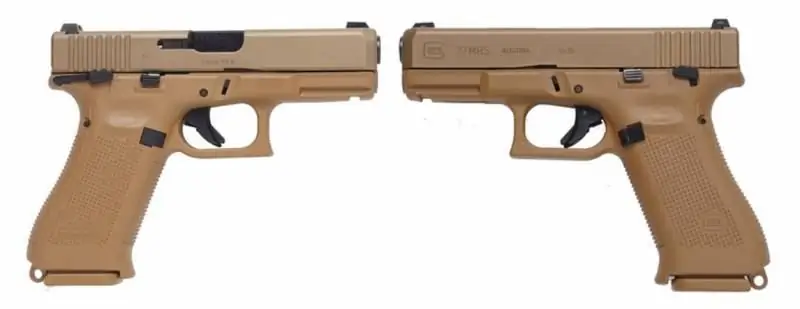
The American company Smith & Wesson participated with the M&P 2.0 (Military and Police) model. The frame of the pistol is made of Zytel polymer with steel inserts, the automation is based on the use of recoil energy with a short barrel stroke, the barrel is locked according to the Browning scheme. The barrel, bolt and other metal parts are made of stainless steel, firing trigger, double-acting only. The pistol grip is modular and has a removable rear part.
Despite the fact that the S&W M&P pistol is actively used by the power structures of the United States and other countries of the world, its design is also not modular in accordance with the requirements of the MHS program. Consequently, Smith & Wesson voluntarily refused to participate in the competition.
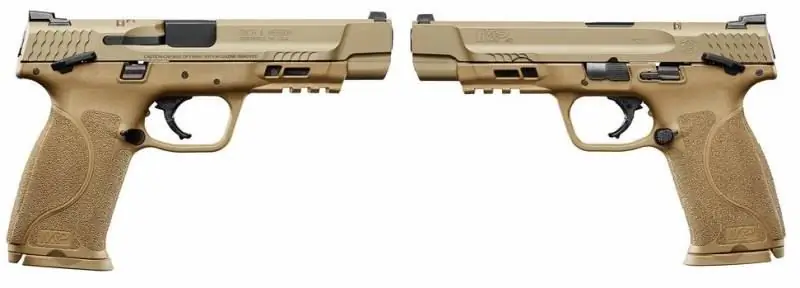

The second American company STI participated with the STX pistol. The chassis of the STX pistol is made of polymer coated 7075 aluminum alloy. The shutter is made of steel. The pistol frame supports four different barrel and bolt lengths, and there are two frame sizes for people with different hand sizes.
The STI STX pistol was withdrawn from the MHS competition without explanation.
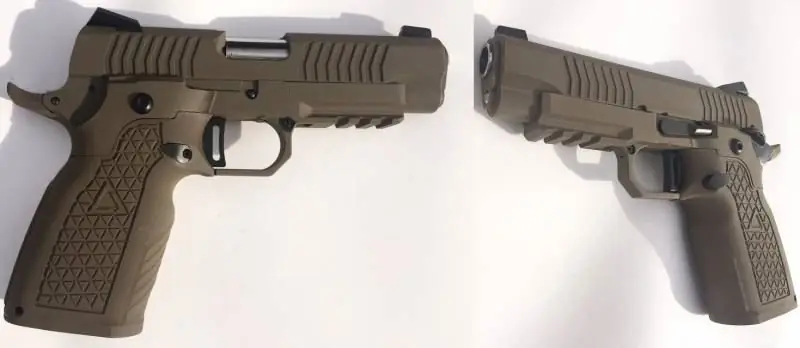

Finally, we come to the winner. The US Armed Forces announced on January 19, 2017 that the winner of the MHS competition was the SIG Sauer P320 pistol in full-size and compact versions. A contract worth $ 580, 217 million will be awarded to SIG Sauer. In the US Army, the pistol will receive the designations M17 for the full-size version and M18 for the compact version.
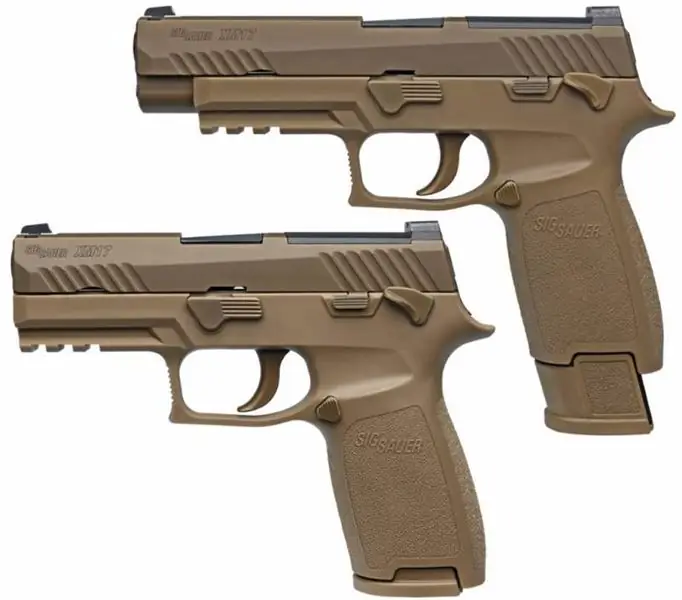
The original SIG Sauer P320 has the maximum modularity of all the samples presented. The trigger can be inserted into frames of various sizes (full-size, compact, subcompact), with shutter-casings of various lengths and barrels of different lengths and calibers - 9 × 19,.357SIG,.40 S&W and.45 ACP.
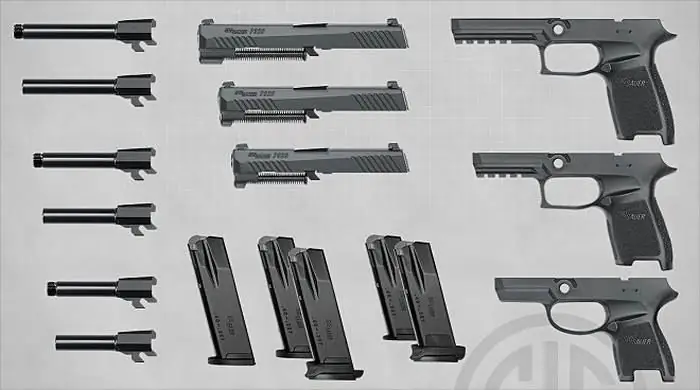
The replaceable frame of the M17, M18 pistols is polymer, but includes a removable metal base with trigger parts and slide guides for the bolt, therefore, the movement of the bolt-casing and barrel does not lead to wear of the polymer frame. The number of the weapon is embossed on a metal base, a slot is made in the frame so that this number can be seen.
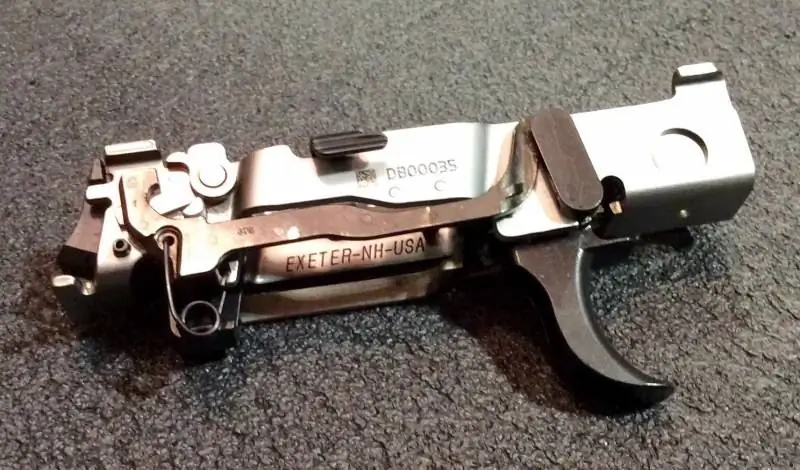
The pistols use automatic equipment with a movable barrel and a short stroke, with locking by a skewed breech of the barrel. USM striker, with preliminary partial cocking. Complete assembly and disassembly of M17, M18 pistols require special tools, as stipulated in the terms of the MHS program.
M17 and M18 pistols are equipped with double-sided manual safety locks and slide stop levers on the frame. Magazine latch, can be installed on either the left or right side. The rear sight is installed on a special removable platform, on the pistol bolt-cover. Instead of the entire platform, compact collimator sights can be installed, including those that are compatible with night vision devices. Pistols can be equipped with extended threaded barrels for installing a silencer.
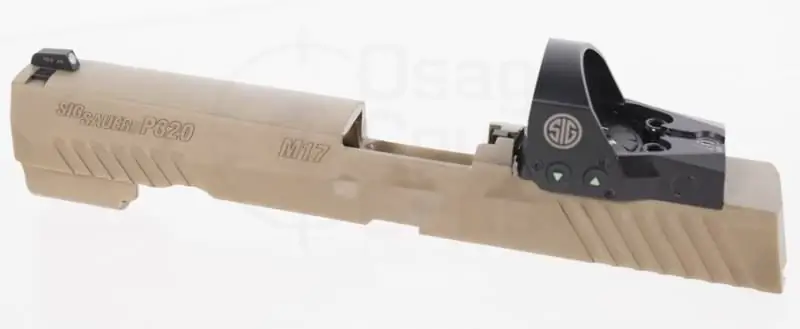
The length of the grips and the magazines used for the M17 and M18 pistols are the same. The pistols are delivered to the troops assembled, equipped with two additional replaceable plastic frames with handles in the L, M and S sizes, that is, large, medium and small.
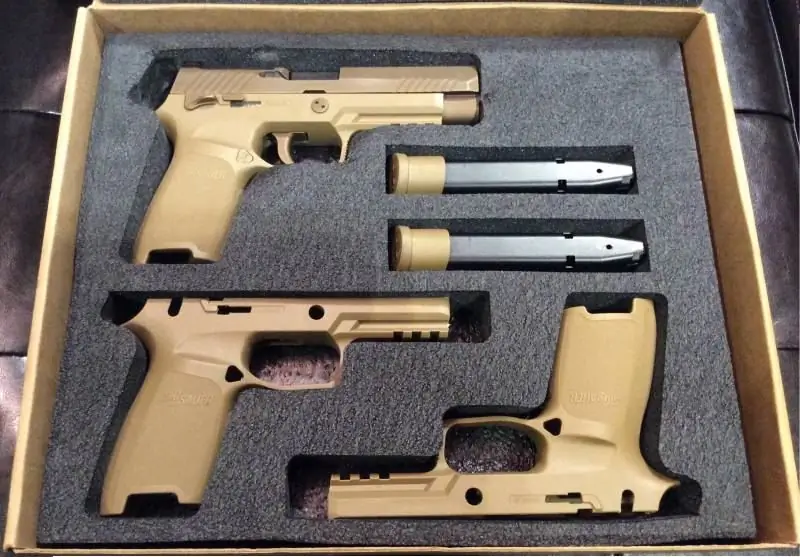
In January 2017, reports emerged that a Connecticut police officer was injured due to an accidental shot when his P320 fell to the ground. This problem also extended to the P320 pistols sold in the civilian market, however, according to SIG Sauer, this problem has been eliminated in the M17 and M18 pistols, and at the moment should be solved in the "civilian" samples.
Information appeared about some other problems of SIG Sauer M17, M18 pistols, such as accidental shots, ejection of non-fired cartridges (double ejection - when, along with the cartridge case, the unused ammunition following it flew out during firing), frequent delays when using bullets with an all-metal sheath … According to some sources, the listed problems were related to the initial phase of testing and were eliminated in serially supplied weapons, according to other sources, these problems were revealed by servicemen from combat units who had already received new pistols.
On the other hand, given the number of pistols sold by SIG Sauer, the problems are unlikely to be widespread, and one must look for their root causes. In the end, no one has yet succeeded in creating a structure that another cannot break.

What conclusions can be drawn?
Compared to the first army pistol competition, which lasted nearly a decade, the MHS competition was held in less than two years, with little or no scandal, aside from a complaint from Glock. However, who knows what will happen in six months or a year, if the problems do not stop, it is quite possible that the results will be canceled and they will start choosing again …
There is a feeling that some companies entered the competition for the MHS program for show. It seems like there is a competition, and there are participants, but there is no rivalry as such, either they have withdrawn themselves, or rejected for unknown reasons. In Russia, the topic of a "fake" tender is well known when the terms of reference (TOR) are adjusted in such a way that only one supplier could meet them. It is likely that the stronghold of democracy has also long been familiar with this scheme. In the end, the Glock was not chosen, was it a conspiracy?
On the other hand, it cannot be ruled out that the participating companies and the customer (the US Armed Forces) sign an agreement on the confidentiality of the test results in the competition so that the revealed shortcomings of a particular weapon model do not reduce sales to other departments and private buyers.
Unlike the 1978-1988 army pistol competition, all manufacturers offered classic designs. No discharge of powder gases, no rotating barrels, no automatic fire and other exotics.
In any case, the specification for a new weapon model is a set of compromises between the desired characteristics and the capabilities of the suppliers. A company that can manufacture a limited batch of a constructively perfect pistol may not be able to launch large-scale production of it. The desire to change the caliber to a more efficient one stumbles upon warehouses littered with cartridges of the caliber in use.
In view of the above, the US armed forces have received a decent pistol (kit) that can meet their needs for this type of weapon for the coming decades.






